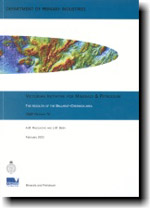VIMP Report 76 - The regolith of the Ballarat–Creswick area
 |
| |||||||||||||||
Product description:Download The downloadable version of this report is supplied in PDF format. Abstract Regolith mapping in the Ballarat–Creswick area of central Victoria was completed to define the major regolith–landform units and to characterise the bedrock geochemistry with respect to these landform units. The mapping centred on a 10 x 28 km zone extending from the Ballarat East goldfield in the south, north to Spring Hill, east of Creswick. The area was selected as a typical cross-section of the central Victorian goldfields, incorporating a wide range of elements in the landscape, a variety of differing surface and bedrock geological units and a centre of significant gold production. Mapping identified twenty-six regolith–landform units that broadly fall within either saprolite-dominated hills and rises or transported cover. A statistical examination of the geochemistry combined with clay mineralogy of the saprolitic bedrock units highlighted several trends that may act as a vector for gold mineralisation. Across the Ballarat East line-of-lode, gold is associated with K–Rb–Ba–Al in near surface, bleached, very highly weathered saprolite. This represents illite–sericite and kaolinite alteration of regional metamorphic chlorite within bedrock turbidites. On the margins of the bleached zone, a ferruginous halo defined by goethite and haematite is associated with Fe–Mn–Cu–Bi–As. In the soils a similar geochemical trend to the bedrock is observed, complicated by differing soil horizons and degrees of weathering. In general, the most reliable sample medium was found to be the C-horizon, where the clay composition is predominantly illite/sericite and the geochemistry is the most representative of the bedrock. The combination of geochemistry and landscape position of the Ballarat East goldfield has implications for exploring for similar deposits both at surface and under cover. The high standing relief of the goldfield is believed to be a reflection of the mechanical strength imparted by the intense stockwork of quartz veining associated with mineralisation along the White Horse Range. Topographic and palaeotopographic highs (the latter beneath cover), coincident with pallid, highly crystalline, muscovitic illite and Fe-carbonate alteration are all indicative of hydrothermal mineralising systems. In contrast, pallid, less crystalline, very highly weathered kaolinitic saprolite in low landscape positions are less prospective and sampling difficult to interpret, particularly where there is potential for gold contamination via current or stripped overlying Cainozoic placer deposits. Bibliographic reference Radojkovic, A.M. & Bibby, L.M., 2003. The regolith of the Ballarat–Creswick area. Victorian Initiative for Minerals and Petroleum Report 76. Department of Primary Industries. Related products:
| ||||||||||||||||


